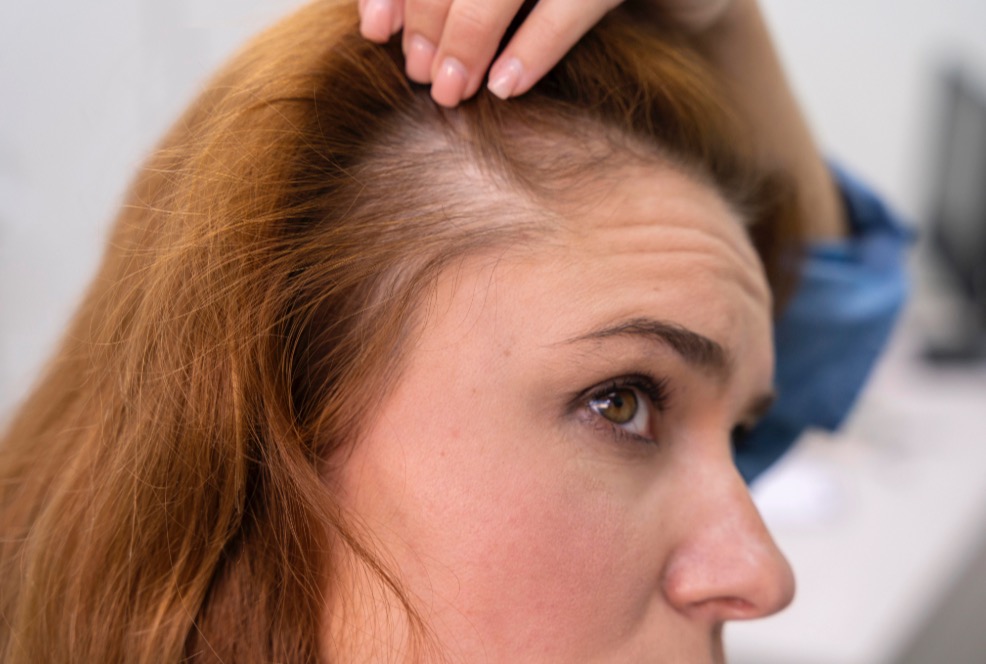
Hair loss is a common concern that many women experience as they age. However, when it comes to hair thinning or shedding that follows a certain pattern, it could be a condition known as Female Pattern Hair Loss (FPHL). While it’s normal for hair to shed every day, FPHL involves a gradual thinning of the hair along the top of the scalp, leading to noticeable changes.
If you’ve noticed your hair becoming thinner, or perhaps you’re seeing more strands on your pillow, it might be time to learn more about FPHL and what you can do about it.
What is Female Pattern Hair Loss?
FPHL is the most common cause of hair loss in women, typically occurring after menopause but also affecting younger women. Unlike male pattern baldness, which can cause large bald patches, FPHL leads to diffuse thinning, particularly around the crown and the parting of the hair.
The key difference is that while male pattern baldness results in a receding hairline and patches of baldness, FPHL usually causes an overall decrease in volume and thickness.
Causes of Female Pattern Hair Loss
The causes of FPHL are multifactorial. While genetics play a major role, hormonal changes—especially those related to menopause—can significantly contribute to hair thinning. Other factors include:
– Hormonal changes: Decreased estrogen and progesterone levels during menopause, pregnancy, or certain medical conditions can affect the growth phase of the hair cycle.
– Genetics: A family history of hair loss can increase your risk of developing FPHL.
– Age: As you get older, hair naturally thins due to slower hair growth.
– Stress: High stress levels can trigger a type of hair loss known as telogen effluvium, which may exacerbate FPHL.
How to Identify Female Pattern Hair Loss
You may notice:
– Thinning on the top and crown: Unlike other forms of hair loss, FPHL usually starts as gradual thinning, particularly around the crown and parting.
– Receding hairline: It can sometimes affect the hairline, though not as drastically as in men.
– Less volume: Hair feels less dense, and your ponytail may feel thinner.
If you’re unsure whether you’re dealing with FPHL, a dermatologist can help with an evaluation and may recommend tests to rule out other causes of hair loss.
Treatment Options
The good news is there are effective treatments available to manage Female Pattern Hair Loss. While there isn’t a permanent cure, here are some options that can help:
1. Topical Minoxidil (Rogaine): FDA-approved for both men and women, this topical solution can help to promote hair growth and slow down the thinning process. It works best when applied at the first signs of hair loss.
2. Platelet-Rich Plasma (PRP) Therapy: This involves drawing a small amount of your blood, processing it to concentrate platelets, and then injecting it into the scalp to stimulate hair growth.
3. Hair Transplant Surgery: For women who experience significant hair thinning or bald patches, a hair transplant can be a more permanent solution. It involves taking hair follicles from areas of your scalp where hair growth is still strong and transplanting them into areas that are thinning.
4. Oral Medications: Certain medications like spironolactone can help address hormonal imbalances contributing to hair loss, particularly if the condition is related to an excess of androgens (male hormones).
5. Nutritional Support: A well-balanced diet rich in vitamins and minerals, such as iron, biotin, and vitamin D, can help support hair health. Supplements may also be recommended if you have deficiencies.
6. Low-Level Laser Therapy (LLLT): This FDA-cleared treatment uses light to stimulate hair follicles and promote hair regrowth. It’s available in in-office treatments or at-home devices like laser combs.
Lifestyle Tips for Managing Female Pattern Hair Loss
While treatments can be effective, there are lifestyle changes you can make to help manage hair loss:
– Be gentle with your hair: Avoid harsh hairstyles, excessive heat styling, or tight ponytails that can put strain on your hair.
– Reduce stress: Practice stress-reducing techniques like yoga, meditation, or deep breathing to prevent hair thinning triggered by stress.
– Healthy diet: Focus on a nutrient-rich diet, rich in fruits, vegetables, and lean proteins, to nourish your hair from the inside out.
Experiencing hair thinning can feel distressing, but it’s important to remember you’re not alone—many women experience FPHL, and there are treatments available to help you manage it. Consulting our dermatologist, Dr. Robles, can help you determine the best course of action for your specific condition.
Don’t hesitate to take action early, as the sooner you start a treatment plan here at Oak Tree Dermatology, the more effective it can be in preserving and regrowing your hair. Embrace the journey to healthier, fuller hair!


